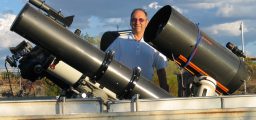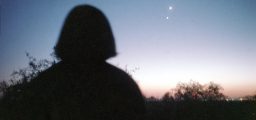Skyward for June 2020

Skyward for June 2020.
By David Levy
Castor House
A number of years ago, my friend Scott Roberts, then of Meade Instruments, sent Wendee and me two small “ETX” telescopes. We brought them both out to a picnic table we had set up in the yard to the south of our home. We turned on their motors and quickly learned how to move them across the sky; as it was Wendee’s first time with a new telescope, she was not as fast as she is now. At one point, Wendee went into the house to answer the telephone. She came out again to find both telescopes purring nicely, with me, and an enormous smile on my face, sitting between them. I grinned like a Cheshire cat.
I have never forgotten that night. We now have a small shed at the spot, and Castor, on a tripod, sits inside along with a lawn chair I use for meteor observing. Castor house, as I call it, is now one of my favourite viewing spots. It affords a magnificent view of the night sky, especially for watching meteors. I even installed an outdoor speaker there that carries music from KUAT-FM, our local classical music radio station. I walk out there almost every evening, just to check on the sky.
What do I check for? One never knows when the sky will offer something new and unexpected. What if, since the night before, a distant sun somewhere in our galaxy has awakened, thrown off its covers, and rose in brightness as an exploding star or a nova? These events cannot be predicted. In 1572, the Danish astronomer Tycho Brahe peered skyward and saw a brilliant new star in the constellation of Cassiopeia. What he saw was not an “ordinary” nova wherein the star rises and fades in brightness. His star was a supernova that resulted in the total collapse and destruction of the star. Just 32 years later, his student, Johannes Kepler, discovered a second supernova in the constellation of Ophiuchus. Since then, 416 years later, there has not been one visible supernova in our own galaxy.
On August 30, 1975, I stepped out of a car on my way to a card game, looked up, and saw what appeared to be a slow moving satellite near the bright star Deneb. I went indoors, then stepped outside again to note that the satellite was moving very, very slowly indeed. Then I understood that the “satellite” was not moving at all. I had made an independent discovery of an exploding star, not a supernova but an “ordinary” nova. Three years later, on September 12, 1978, from a campground in the Adirondack mountains, I independently found a second nova.
Most of these ordinary novae, like the two I found, can recur, again and again. In fact, there is one star that has already exploded twice in recent memory. On May 12, 1866, the star named T Coronae Borealis or the “Blaze Star”, rose to almost second magnitude. On February 9, 1946 it erupted again, this time to about third magnitude. There is a very good chance that within the next decade it will explode again. Stars like T coronae Borealis are called “recurrent novae.”
When will the next unexpected stellar event disturb the symmetry of the familiar night sky? We are surely due for one. How about tonight? Wouldn’t that be fun? The night sky is lovely and beautiful, but it is also astounding. We just never know what will come next. Maybe tonight I will find one again, as I stroll by Castor House.




Comments are closed.